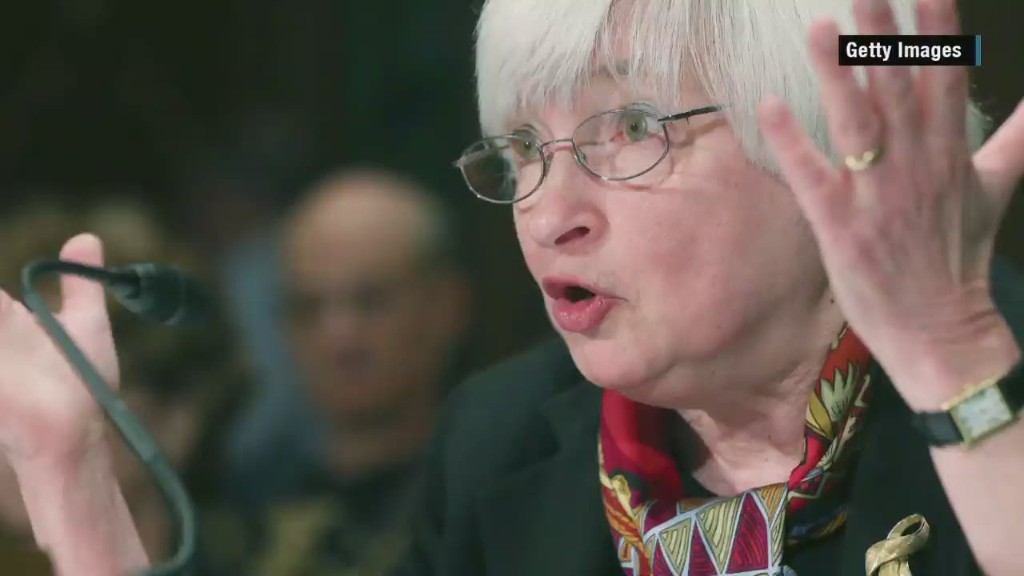
Let's face it: America's central bank -- the Federal Reserve -- doesn't speak English.
If you haven't had the pleasure of interpreting the Fed's words, it's like being Bill Murray trying to make his way around Japan in the movie "Lost in Translation" (minus Scarlett Johansson).
The Fed's committee meets Tuesday and Wednesday, and it will be the most watched event on Wall Street. That is, unless another CEO calls it quits like Rupert Murdoch at Fox (FOXA) and Dick Costolo at Twitter (TWTR) did last week.
It's a good time to brush up on your "Fed Speak" because this meeting could be more dramatic than previous ones. Expect stocks and bonds to react, possibly with more wild swings.
Related: Pay attention to the chaos in the bond market
Fed Chair Janet Yellen strongly hinted in May that the Fed will raise rates "at some point this year." But the World Bank and International Monetary Fund are urging the Fed not to raise rates until 2016 because the U.S. economy isn't strong enough yet.
The Fed hasn't responded to its critics, but Yellen will face the media Wednesday, and it's likely she will be pressed to defend the Fed's stance. It doesn't get much juicier for the Fed than this.
Now, no one expects the Fed to raise rates this week. Most believe that will happen in September. But the Fed's actions affect over 100 million of American households -- anyone with a bank account or trying to get a loan -- making Fed Speak critical to understand.
Related: Yellen: Fed can't risk 'overheating the economy'
Here's a few simple translations and their meaning:
Fed Speak: "Liftoff"
English: The first time the Fed will raise interest rates after being near zero for 6 years.
Why you should care (WYSC): Liftoff would be a healthy sign for the U.S. economy. It mean the Fed believes America is almost fully recovered from the Great Recession.
When interest rates finally rise, it also means the rate on your savings account at your bank should go up.
Experts believe the Fed will start raising rates in September, although the central bank has not been specific. The Fed would like to -- but is not required to -- see more wage growth for workers before liftoff.
Fed Speak: "Transitory"
English: Temporary things, like cold winter weather (even if it feels like it will never end in Boston).
WYSC: The U.S. economy contracted in the first three months this year, canceling any possible plans for the Fed to liftoff in June. The Fed believes the contraction was due to temporary factors, like the cold winter weather and West Coast port strike.
The Fed expects the economy will bounce back in the spring and summer, which would justify a rate hike. But other factors once thought to be temporary -- the strong U.S. dollar -- have persisted. Everyone from Wall Street to Washington is looking to see if America's economy picks up momentum as the weather warms up, much as it did last year.
Related: U.S. economy contracted in the first quarter but don't panic
Fed Speak: "Shallow"
English: Moving slowly. The Fed is expect to raise interest rates in small and spaced out doses after liftoff.
WYSC: New York Fed President William Dudley used "shallow" in a speech in April, and the Dow surged over 100 points that day. It's similar to another often used Fed word: normalization.
Investors are worried a rate hike will end or disrupt the stock market's 6-year bull market. So a series of "shallow" hikes would be easier for the stock market -- and everyone else -- to digest.
Wall Street has worried about liftoff for years. But many economists now say that the initial liftoff is less important than what the Fed does after that. The idea is that speed (how often) and size (how large of a rate hike) are more important than when the Fed actually gets the rate hike party started.
The Fed's pace will affect mortgage rates, credit card debt and a slew of other big-ticket items. Even in you're not investing, the Fed's pace will impact many things you buy.
Related: IMF: Fed shouldn't raise rates until 2016
Fed Speak: "The intermeeting period"
English: June 17 to July 28 AND July 29 to September 16.
WYSC: The Fed uses this term instead of normal time references like weeks, months or years.
The U.S. economy will be front and center between late June and mid-September. With a slow first quarter, the Fed wants to see a healthy pick up in consumer spending, inflation and wages, not to mention stronger GDP growth. The job market must keep its pace going too.
The Fed's next meeting is in July (July 28-29), but it's highly unlikely they would raise rates at a meeting where there is no scheduled press conference afterward that allows them to explain their thinking in detail. The next meeting with a media briefing is in September.
So after this week's meeting, every bit of economic data until September will be scrutinized extra by investors, analysts, and, you bet, Fed journalists.


